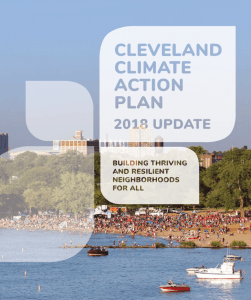A growing consensus among experts indicates that the climate in northeast Ohio is changing. Temperature extremes are becoming pronounced, with more heat waves in the summer and a greater frequency of extreme rain storms. Without action these trends will likely continue, exposing already vulnerable populations to increased natural hazards. The City of Cleveland is helping its residents adapt to the changing climate by engaging in climate action planning. By producing a Climate Action Plan (CAP) the City is not only helping local stakeholders mitigate the effects of climate change, but also creating economic, environmental, and socially equitable benefits for all Clevelanders.
In 2018 the City of Cleveland led a collaborative process of updating its already existing plan for climate action. Cleveland first produced a CAP in 2013, which has led to undeniable water and air quality improvements, increased usage of solar and wind energy, and the inception of innovative sustainability programs like a city-wide bike share system and municipal tree plan. The 2018 updates seek to build on the progress of the original CAP and increase attention in four areas: (1) social and racial equity, (2) green jobs, (3) resilience to the impacts of climate change, and (4) business leadership.
Ohio Sea Grant and Ohio State University Extension participated in efforts to update the 2018 CAP by serving on the Climate Action Advisory Committee (CAAC), along with representatives from local government agencies, nongovernmental organizations, businesses, technical experts, and concerned residents. In addition to producing the actual action plan, the CAAC helped organize and inform community workshops where more than 300 local residents were given the opportunity to voice their concerns and priorities for climate action in their respective communities.
The framework for the CAP is organized around five focus areas that constitute the main objectives, goals, and actions needed to help build climate resilience. The focus areas include: energy efficiency and green building; clean energy; sustainable transportation; clean water and vibrant green space; and more local food and less waste. Each focus area is investigated in detail in the CAP, as well as how it impacts the City’s carbon footprint.
For those interested in learning more about Cleveland’s CAP, you can access an online version here. More information on sustainability efforts in and around Cleveland can also be found at www.sustainablecleveland.org, or by visiting the webpage for the Cleveland Mayor’s Office of Sustainability. We all have a role to play in climate adaptation, and Cleveland’s CAP is a great roadmap for northeast Ohioans eager to get started.
 Scott Hardy is an Extension educator for the Ohio Sea Grant College Program.
Scott Hardy is an Extension educator for the Ohio Sea Grant College Program.
The content of this site is published by the site owner(s) and is not a statement of advice, opinion, or information pertaining to The Ohio State University. Neither text, nor links to other websites, is reviewed or endorsed by The Ohio State University.
